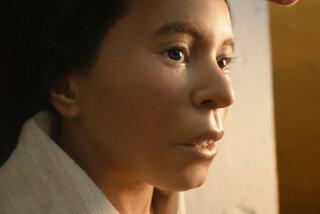Tests Show Mummy Was No Infant : Discovery: X-rays and CAT scans prove Peruvian specimen, thought to be a baby, is actually a young adult, researchers say.
- Share via
A Peruvian mummy, on exhibit in a local museum for years as a specimen of an ancient infant, actually is the remains of a teen-ager or young adult, a team of scientists said Friday.
San Diego radiologist Hano A. Siegel said he and his colleagues asked the Museum of Man here if it could examine the contents of a Peruvian sarcophagus in mid-July, and only recently completed their findings.
He said the success of modern radiology in anthropological studies around the nation prompted his interest in the field.
Siegel, an executive with the Radiology Medical Group of San Diego, said the series of X-rays and CAT (computer-assisted tomography) scans proves that the body inside was “at least an early teen-ager,” even though it was less than 3-feet long.
“It was shriveled up in the fetal position,” Siegel said. “The museum people had thought for years it was an infant, but the scan showed it didn’t have an infant’s bones. The other doctors were all in agreement. Anyone who would have looked at it would have assumed it was an infant.”
The person’s height would have been from 2 feet 10 inches to 3 feet 6 inches, he said, small by modern standards but not for some ancient populations of Peruvian Indians. The mummy is believed to be more than 1,000 years old.
Siegel was assisted by Dr. Myron Marx, a San Francisco radiologist who has examined Egyptian mummies, and Dr. Ethan Braunstein, a New York radiologist who specializes in anthropological research.
Rose Tyson, curator of physical anthropology at the Museum of Man in Balboa Park, said the mummy was loaned to the museum in 1936 and given to it in 1978. It has been on exhibit, labeled as an infant, she said, “but we’ll have to change our labeling.
“It was certainly an interesting development for us,” Tyson said. “It had always been considered an infant. Any new information--especially of this magnitude--is always good for a museum. The more information we have about specimens, the better able we are to catalogue, do research, et cetera. It just adds to a more complete picture.”
Siegel said the mummy had one set of teeth, “like an adult, whereas kids have two sets of teeth. Kids have openings at the ends of their bones, but, in this case, the bones were closed, indicating the bones had finished growing.
“Inside the head, the membranes around the brain contained calcium--membranes tend not to calcify in children but do in adults. This is a way-out possibility, but calcification in the pelvis of the mummy could indicate a dead pregnancy. We also saw impacted wisdom teeth, which can occur in adults.”
Siegel said he could not be sure about the pregnancy, or of the mummy’s gender or exact age at the time of death.
Siegel said the radiologists examined a second sarcophagus that museum anthropologists believed contained a hawk, which turned out to be a corn mummy, full of corn seed, meant as an offering to the gods.
“They were thrilled with that,” Siegel said, “because such things are extremely rare.”
Siegel said the third sarcophagus contained an Egyptian ibis, a large bird related to a heron and found primarily in tropical or desert regions.
“We were able to tell it had a beak, a spine and bills,” Siegel said.
Tyson said the corn mummy is on loan to the museum, while the ibis is part of its permanent collection. These, along with the Peruvian Indian mummy, are all on exhibit.
More to Read
Sign up for Essential California
The most important California stories and recommendations in your inbox every morning.
You may occasionally receive promotional content from the Los Angeles Times.













